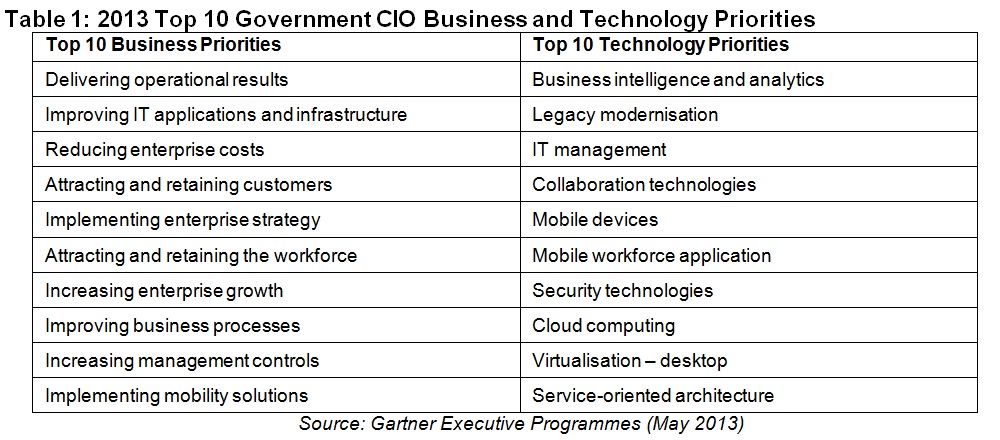Private sector hunkers down, but govt IT budgets rise: Gartner
By Digital News Asia August 14, 2013
- Years of being told to ‘do more with less,’ many government CIOs now have stable or increasing budgets
- 76% of government CIOs don’t just ‘keep the lights on,’ have leadership responsibilities outside of IT
 DESPITE a continuing drive to lower the cost of IT services, nearly 75% of government IT budgets globally were reported as flat or increasing in 2013, according to the Gartner Executive Programmes 2013 CIO Agenda survey.
DESPITE a continuing drive to lower the cost of IT services, nearly 75% of government IT budgets globally were reported as flat or increasing in 2013, according to the Gartner Executive Programmes 2013 CIO Agenda survey.
These findings are in contrast to the private sector, which is significant as management practices, financial indicators, business metrics and the adoption of IT in government generally lag behind those of the private sector, Gartner said in a statement.
Speaking ahead of his presentation at Gartner Symposium/ITxpo in October, Gartner research director Rick Howard said: “After years of being told to ‘do more with less,’ many government CIOs (chief information officers) report that budgets have stabilised or are increasing, placing them in a better position to deliver and manage IT services more effectively and efficiently.
“These CIOs are now poised to boost the business value of IT by radically restructuring their services portfolio to drive innovation and improve the performance of government,” he said.
When compared to other sectors of the economy, the relatively brighter IT budget outlook in government may be short-lived, according to Gartner analysts.
Gartner's CEO and Senior Executive Survey 2013 indicates that private-sector business leaders are poised to boost investments in e-commerce, mobile, cloud, social and other major technology categories.
Despite this, Gartner projects a modest compound annual growth rate of 1.3% for IT spending in the government and education sectors through to the end of 2017, with increased spending for IT services, software and data centres.
These increases are offset by reductions in internal technology services, devices and telecom services.
Gartner’s latest annual survey of 1,959 CIOs worldwide from all industries was conducted in the fourth quarter of 2012 and represents CIO budget plans reported at that time.
CIOs in government indicated that reducing overall business costs is now more important than reducing IT costs alone, which will permit government CIOs to accelerate enterprise-scale initiatives.

The business and technology priorities of government CIOs are strongly aligned with their peers from all industries globally, with a few small differences.
For the third consecutive year, reducing enterprise costs ranks among the top three business priorities for government CIOs in 2013.
In conjunction with the imperative to deliver operational results and the need to modernise IT applications and infrastructure, CIOs have affirmed the means by which IT can be used to transform government agency operations and their own bottom-line accountability to do so.
“When faced with unsustainable business models, government executives are more willing to make targeted technology investments and undergo the extensive organisational change necessary to achieve the productivity and quality gains made possible by IT,” said Howard.
“Introducing new technology services and workforce capabilities will establish IT as a key partner in achieving business results that matter to citizens and agency employees,” he added.
The top three technology priorities in 2013 have all changed since 2012, with business intelligence and analytics moving from No 5 to the top spot, followed by legacy modernisation and IT management.
By placing analytics and business intelligence at the top of the list, government CIOs are addressing government's need to proactively manage programmes and services, Gartner said.
As part of the CIO agenda survey, strategic priorities are also investigated and ranked. Improving the government IT organisation and workforce has moved to the No 2 spot in 2013 from No 9 in 2012, which shifts the responsibilities of CIOs and IT professionals away from most legacy technology services to underserved areas of business need.
“To support broad institutional change, CIOs recognise they must invest in a workforce that can collaborate effectively with agency leaders and programme managers to identify business priorities, as well as design and implement solutions that match those priorities,” said Howard.
The CIO Agenda Survey also indicated that 76% of government CIOs have significant leadership responsibilities outside of IT.
“What is certain is that many of the information, business process and project management roles that have been developed over time by IT on a default or ‘best fit’ basis are now being embraced as competencies by business units, as a result of consumerisation and the commoditisation of technology,” said Howard.
“Rather than viewing these trends as a threat, astute CIOs will embrace them as a means to extend their influence and value to areas outside of traditional IT,” he added.
Further information is available in the Gartner report ‘Government CIO Agenda 2013: 'Do Better With the Same'.
Related Stories:
CIOs: We’re being held back by other C-levels
Embrace changing trends or perish, says Gartner
Post-PC era: Three implications for CIOs, IT leaders
BYOD: Kill off those old IT policies, CIOs
For more technology news and the latest updates, follow @dnewsasia on Twitter or Like us on Facebook.


